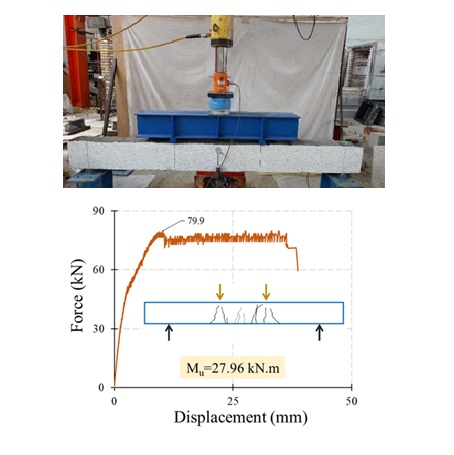Simplified Unified Model for Flexural Capacity of Ductile HPC Beams with A Low Reinforcement Ratio
DOI:
https://doi.org/10.61186/7.3.1Keywords:
Beam, HPC, Flexural Capacity, Low Reinforcement Ratio, Fiber RoleAbstract
There is no specific model to predict the flexural capacity of ultra-high-performance concrete (UHPC) beams with a low reinforcement ratio. Accordingly, a comprehensive experimental database containing 162 datasets was gathered from literature to propose an explicit analytical model containing various critical features, including fiber volume fraction, fiber aspect ratio, fiber strength, water-to-binder () ratio of mixture, and reinforcement ratio. Additionally, a supplementary experimental study involving a large-scale UHPC beam with a very low reinforcement ratio (almost negligible) was conducted to verify the model's performance. The findings revealed that the proposed bending model achieved an IAE of 10.8% and a COV of 1.04, indicating its high accuracy in comparison to a comprehensive experimental dataset comprising 162 large-scale beam tests. Furthermore, the comparison between the experimental results of the tested beam and the proposed model showed a deviation of 4.5%, which supports the effectiveness of the flexural capacity formulation. A parametric statistical analysis was conducted using Minitab software to evaluate the influence of key parameters affecting the roles of fiber and matrix.
References
[1] Yang, In Hwan, Changbin Joh, and Byung-Suk Kim. “Structural behavior of ultra-high performance concrete beams subjected to bending.” Engineering Structures 32.11 (2010): 3478-3487. https://doi.org/10.1016/j.engstruct.2010.07.017
[2] Meda, A., F. Minelli, and G.A. Plizzari. “Flexural behaviour of RC beams in fibre reinforced concrete.” Composites Part B: Engineering 43.8 (2012): 2930-2937. https://doi.org/10.1016/j.compositesb.2012.06.003.
[3] Kamal, M., M. Safan, Z. Etman, and R. Salama. “Behavior and strength of beams cast with ultra high strength concrete containing different types of fibers.” HBRC Journal 10.1 (2014): 55-63. https://doi.org/10.1016/j.hbrcj.2013.09.008.
[4] Abbas, S., A.M. Soliman, and M.L. Nehdi. “Exploring mechanical and durability properties of ultra-high performance concrete incorporating various steel fiber lengths and dosages.” Construction and Building Materials 75 (2015): 429-441. https://doi.org/10.1016/j.conbuildmat.2014.11.017.
[5] Yoo, Doo-Yeol, Nemkumar Banthia, and Young-Soo Yoon. “Experimental and numerical study on flexural behavior of UHPFRC beams with low reinforcement ratios.” (2016). http://hdl.handle.net/1807/75095.
[6] Yoo, Doo-Yeol and Doo-Yong Moon. “Effect of steel fibers on the flexural behavior of RC beams with very low reinforcement ratios.” Construction and Building Materials 188 (2018): 237-254. https://doi.org/10.1016/j.conbuildmat.2018.08.099.
[7] Cardoso, D.C., R.C. Silva, J.P.C. Rodrigues, and A.T. Marques. “Influence of steel fibers on the flexural behavior of RC beams with low reinforcing ratios: Analytical and experimental investigation.” Composite Structures 222 (2019): 110926. https://doi.org/10.1016/j.compstruct.2019.110926.
[8] Abbasi Parvin, Younes, Mohammad Ali Hadianfard, Amirhossein Gholamrezaei, and Sajad Bagheryan. “Flexural behavior of UHPC beams reinforced with macro-steel fibers and different ratios of steel and GFRP bars.” Journal of Rehabilitation in Civil Engineering 12.2 (2024): 41-57. https://doi.org/10.22075/jrce.2023.28070.1695.
[9] JSCE. “Standard Specifications for concrete structures.” Japanese Society for Civil Engineering (JSCE) (2010). https://www.jsce-int.org/system/files/JGC15_Standard_Specifications_Design_1.0.pdf.
[10] Yoo, Doo-Yeol and Young-Soo Yoon. “Structural performance of ultra-high-performance concrete beams with different steel fibers.” Engineering Structures 102 (2015): 409-423. https://doi.org/10.1016/j.engstruct.2015.08.029.
[11] Singh, M., I. Sheikh, M. Ali, M. Shariq, and A. Baqi. “Experimental and numerical study of the flexural behaviour of ultra-high performance fibre reinforced concrete beams.” Construction and Building Materials 138 (2017): 12-25. https://doi.org/10.1016/j.conbuildmat.2017.02.002.
[12] Hasgul, U., K. Turker, A. Birol, and A. Yavas. “Flexural behavior of ultra‐high‐performance fiber reinforced concrete beams with low and high reinforcement ratios.” Structural Concrete 19.6 (2018): 1577-1590. https://doi.org/10.1016/j.conbuildmat.2017.02.002.
[13] Gümüş, M. and A. Arslan. “Effect of fiber type and content on the flexural behavior of high-strength concrete beams with low reinforcement ratios.” Structures (2019). https://doi.org/10.1016/j.istruc.2019.02.018.
[14] Liu, S., W. Wang, L. Mao, and Z. Li. “Flexural load-deflection performance of polyvinyl alcohol fiber reinforced cementitious composite beams.” Construction and Building Materials 223 (2019): 1135-1144. https://doi.org/10.1016/j.conbuildmat.2019.07.215.
[15] Turker, K., U. Hasgul, A. Birol, and A. Yavas. “Hybrid fiber use on flexural behavior of ultra high performance fiber reinforced concrete beams.” Composite Structures 229 (2019): 111400. https://doi.org/10.1016/j.compstruct.2019.111400.
[16] Conforti, A., R. Zerbino, and G. Plizzari. “Assessing the influence of fibers on the flexural behavior of reinforced concrete beams with different longitudinal reinforcement ratios.” Structural Concrete 22.1 (2021): 347-360. https://doi.org/10.1002/suco.201900575.
[17] Chen, H.-J., W.-C. Huang, C.-C. Huang, and Y.-W. Chan. “Flexural behavior of ultra-high-performance fiber-reinforced concrete beams after exposure to high temperatures.” Materials 14.18 (2021): 5400. https://doi.org/10.3390/ma14185400.
[18] Jin, H., F. Li, and D. Hu. “Research on the flexural performance of reinforced engineered cementitious composite beams.” Structural Concrete 23.4 (2022): 2198-2220. https://doi.org/10.1002/suco.202100012.
[19] Mousavi, S., M. Dehestani, and S. Mousavi. “Bond strength and development length of glass fiber-reinforced polymer bar in unconfined self-consolidating concrete.” Journal of Reinforced Plastics and Composites 35.11 (2016): 924-941. https://doi.org/10.1177/0731684416632930.
[20] Wu, Y. F. and X. M. Zhao. “Unified bond stress–slip model for reinforced concrete.” Journal of Structural Engineering 139.11 (2013): 1951-1962. https://doi.org/10.1061/(ASCE)ST.1943-541X.0000747.

Downloads
Published
Issue
Section
License
Copyright (c) 2025 Journal of Civil Engineering Researchers

This work is licensed under a Creative Commons Attribution 4.0 International License.




